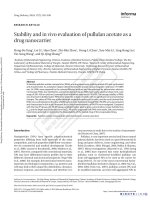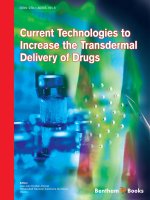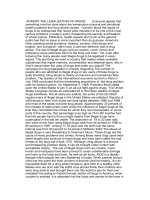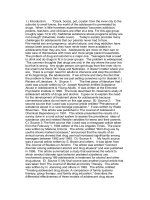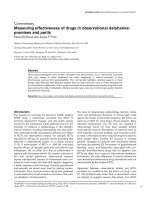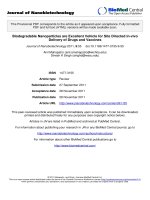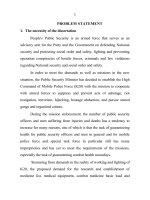Analytical profiles of drug substances and excipients vol 27
Bạn đang xem bản rút gọn của tài liệu. Xem và tải ngay bản đầy đủ của tài liệu tại đây (10.39 MB, 389 trang )
Abdullah A. Al-Badr
Krishan Kumar
Alekha K. Dash
David J. Mazzo
Klaus Florey
Gunawan lndrayanto
Dominic P. Ip
Leroy Shervington
Timothy J. Wozniak
PREFACE
The comprehensive profile of drug substances and pharmaceutical
excipients as to their physical and analytical characteristics continues to be
an essential feature of drug development. The compilation and publication
of comprehensive summaries of physical and chemical data, analytical
methods, routes of compound preparation, degradation pathways, uses and
applications, etc., is a vital function to both academia and industry. It goes
without saying that workers in the field require access to current state-ofthe-art data, and the Analytical Profiles series has always provided
information of the highest quality. For this reason, profiles of older
compounds are updated whenever a sufficient body of new information
becomes available.
The production of these volume continues to be a difficult and arduous
mission, and obtaining profile contributions is becoming ever more
difficult. One cannot deduce whether this is due to the new requirements
of drug development to do more with less, the wide range of activities now
required by professionals in the field, or the continuing personnel downsizing, but the effect is the same. Some companies even take the nearsighted view that publishing a profile will somehow help their ultimate
generic competitors. The latter concern is totally unfounded, since the
publication of a drug substance profile actually sets the standard that the
generic hopefuls would have to meet. The need for analytical profiles
remains as strong as ever, even as potential authors become scarcer all the
time. However, the contributors to the present volume have indeed found
the resources to write their chapters, and I would like to take this
opportunity to salute them for their dedication to this work.
As always, a complete list of available drug and excipient candidates is
available from the editor. I continue to explore new and innovative ways
to encourage potential authors, and welcome suggestions as to how to get
people involved in the writing of analytical profiles. Communication from
new and established authors is always welcome, and Email contact
(address: ) is encouraged. I will continue to look
forward to working with the pharmaceutical community on the Analytical
Profiles of Drug Substances and Excipients, and to providing these
information summaries that are of such great importance to the field.
Harry G. Brittain
AFFILIATIONS OF EDITORS AND CONTRIBUTORS
Abdullah A. AI-Bad~Department of Pharmaceutical Chemistry, College
of Pharmacy, King Saud University, P.O. Box 2457, Riyadh- 11451,
Saudi Arabia
Abdulrahman A. AI-Majed: Department of Pharmaceutical Chemistry,
College of Pharmacy, King Saud University, P.O. Box 2457, Riyadh11451, Saudi Arabia
Mahmoud M. AI-Omari: The Jordanian Pharmaceutical Manufacturing
Co., Naor P.O. Box 94, Amman, Jordan
Mahmoud Ashour: The Jordanian Pharmaceutical Manufacturing Co.,
Naor P.O. Box 94, Amman, Jordan
Adnan A. Badwan: The Jordanian Pharmaceutical Manufacturing Co.,
Naor P.O. Box 94, Amman, Jordan
Harry G. Brittain: Center for Pharmaceutical Physics, 10 Charles Road,
Milford, NJ 08848-1930, USA
Richard D. Bruce: McNeil Consumer Healthcare, 7050 Camp Hill Road,
Fort Washington, PA 19034, USA
Nidal Daraghmeh: The Jordanian Pharmaceutical Manufacturing Co.,
Naor P.O. Box 94, Amman, Jordan
Alekha K. Dash: Department of Pharmaceutical & Administrative
Sciences, School of Pharmacy and Allied Health Professions,
Creighton University, Omaha, NE 68178, USA
William F. Elmquist: Department of Pharmaceutical Sciences, College of
Pharmacy, University of Nebraska Medical Center, Omaha, NE 68198,
USA
Hussein I. EI-Subbagh: Department of Pharmaceutical Chemistry,
College of Pharmacy, King Saud University, P.O. Box 2457, Riyadh11451, Saudi Arabia
Kiaus Florey: 151 Loomis Court, Princeton,NJ 08540, USA
Antonio Cerezo Gahin: Department of Pharmacy and Pharmaceutical
Technology, Faculty of Pharmacy, University of Granada, 18071Granada, Spain
Timothy P. Gilmor: McNeil Consumer Healthcare, 7050 Camp Hill
Road, Fort Washington, PA 19034, USA
Jeffrey Grove: Laboratoires Merck Sharp & Dohme-Chibret, Centre de
Recherche, Riom, France
John D. Higgins: McNeil Consumer Healthcare, 7050 Camp Hill Road,
Fort Washington, PA 19034, USA
Gunawan Indrayanto: Laboratory of Pharmaceutical Biotechnology,
Faculty of Pharmacy, Airlangga University, J1. Dharmawangsa dalam,
Surabaya 60286, Indonesia
Dominie P. Ip: Merck, Sharp, and Dohme, Building 78-210, West Point,
PA 19486, USA
Krishan Kumar: Merial Limited, 2100 Ronson Road, Iselin, NJ 08830,
USA
Jos6 M. Ramos Lrpez: Scientific Instrumentation Center, University of
Granada, 18071-Granada, Spain
Stephen A. Martellueei: McNeil Consumer Healthcare, 7050 Camp Hill
Road, Fort Washington, PA 19034, USA
David J. Mazzo: PreclinicalDevelopment,Hoechst Marion Roussel, Inc.,
Route 202-206, P.O. Box 6800, Bridgewater,NJ 08807, USA
Lina Nabulsi: The Jordanian Pharmaceutical Manufacturing Co., Naor
P.O. Box 94, Amman, Jordan
Niran Nugara: Analytical Development, Schering-Plough Research
Institute, Kenilworth, NJ 07033, USA
Marie-Paule Quint: Laboratoires Merck Sharp & Dohme-Chibret, Centre
de Recherche, Riom, France
Isam Ismail Salem: Department of Pharmacy and Pharmaceutical
Technology, Faculty of Pharmacy, University of Granada, 18071Granada, Spain
Amal Shervington: Faculty of Pharmacy, University of Jordan, Amman,
Jordan
Leroy Shervington: Pharmacy Faculty, Applied Science University,
Amman 11931, Jordan
Richard Sternal: Analytical Development, Schering-Plough Research
Institute, Kenilworth, NJ 07033, USA
Reema AI-Tayyem: Faculty of Agriculture, University of Jordan, Amman,
Jordan
Scott M. Thomas: Merck Research Laboratories, Rahway, NJ, USA
Timothy J. Wozniak: Eli Lilly and Company, Lilly Corporate Center, MC-
769, Indianapolis,IN 46285, USA
ARGININE
Amal Shervington~and Reema AI-Tayyem2
(1) Faculty of Pharmacy
University of Jordan
Amman, Jordan
(2) Faculty of Agriculture
University of Jordan
Amman, Jordan
ANALYTICAL PROFILES OF
DRUG SUBSTANCES AND EXCIPIENTS
VOLUME 27
Copyright © 2001 by Academic Press.
All rights of reproduction in any form reserved.
1075-6280/01 $30.00
2
A. SHERVINGTONAND R. AL-TAYYEM
Contents
.
2.
.
Description
1.1
Nomenclature
1.1.1 Chemical Name
1.1.2 Nonproprietary Names
1.2
Formulae
1.2.1 Empirical
1.2.2 Structural
1.3
Molecular Weight
1.4
CAS Number
1.5
Appearance
1.6
Uses and Applications
Method of Preparation
Physical Properties
3.1
Particle Morphology
3.2
X-Ray Powder Diffraction Pattem
3.3
Optical Rotation
3.4
Thermal Methods of analysis
3.4.1 Melting Behavior
3.4.2 Differential Scanning Calorimetry
3.5
Hygroscopicity
3.6
Solubility Characteristics
3.7
Partition Coefficient
3.8
Ionization Constants
3.9
Spectroscopy
3.9.1 Vibrational Spectroscopy
3.9.2 Nuclear Magnetic Resonance Spectrometry
3.9.2.1 ~H-NMR Spectrum
3.9.2.2 13C-NMRSpectrum
3.10 Micromeritic Properties
3.10.1 Bulk and Tapped Densities
3.10.2 Powder Flowabitity
ARGININE
.
5.
.
Methods of Analysis
4.1
CompendialTests
4.1.1 United States Pharmacopoeia
4.1.2 EuropeanPharmacopoeia
4.2
ElementalAnalysis
4.3
TitrimetricAnalysis
4.4
High PerformanceLiquid Chromatography
4.5
Determination in Body Fluids and Tissues
Stability
D r u g M e t a b o l i s m and P h a r m a c o k i n e t i c s
6.1
6.2
6.3
Metabolism
Pharmacokineticsand Pharmacodynamics
Adverse Effects and Toxicity
Acknowledgements
References
3
4
A. S H E R V I N G T O N A N D R. A L - T A Y Y E M
°
Description
1.1
Nomenclature
1.1.1
Chemical Name
2-amino- 5-guanidinovaleric acid
(S)-2-amino-5- [(aminoiminomethyl)amino]pentanoic acid
1.1.2
Nouproprietary Names
Arginine
L-Arginine
L-(+)-Arginine
1.2
Formulae
1.2.1
Empirical
Arginine: C6H14N402
Arginine Hydrochloride: C6H15N402CI
1.2.2
Structural
H
C02H
I
N---C--H
!
i
~.
H
CH2CH2CH2NH--C=NH
I
NH 2
1.3
Molecular Weight
Arginine: 174.202
Arginine Hydrochloride: 210.663
1.4
CAS Number
123456789
1.5
Appearance
Arginine is a white or almost white crystalline powder, obtained as
practically odorless crystals.
ARGININE
1.6
5
Uses and Applications
Arginine is an amino acid that is best known as a growth hormone
releaser. The decrease of growth hormone in the human body with aging
is a major reason why muscle mass tends to decrease with age, and body
fat tends to increase with age. Decreases in growth hormones also are
partially responsible for the slower rate of skin growth with aging, which
results in thinner and less flexible skin. Injections of growth hormone can
reverse these problems, but there are potential dangers in receiving too
much growth hormone. Growth hormone cannot be taken orally, because
as a peptide, it is broken down in the digestive tract. Growth hormone
injections are so expensive that few people can afford them unless they are
used for a specific disease covered by insurance [1,2].
Dietary arginine supplementation (1%) of a control laboratory chow
containing adequate amounts of arginine for growth and reproduction
increases thymic weight, cellularity, and thymic lymphocyte blastogenesis
in rats and mice [3,4]. In addition, arginine supplementation can alleviate
the negative effect of trauma on these thymic parameters [5]. It has been
demonstrated that arginine becomes an essential amino acid for survival
and wound healing in arginine-deficient rats [6]. This work showed that
1% arginine supplementation of non-deficient rats led to decreased weight
loss on the first day post-injury, and increased wound healing in rats
subjected to dorsal skin wounding [6].
Arginine is also a powerful immune stimulant agent [7-9]. At one time,
this was thought to be exclusively due to its growth hormone releasing
properties, but arginine has been found to be a powerful immune stimulant
and wound healing agent even in the absence of significant growth
hormone release. Long term oral administration of L-arginine reduces
intimal thickening and enhances neoendothelium-dependent acetylcholineinduced relaxation after arterial injury [10]. In addition, oral L-arginine
improves interstitial cystitis symptom score [ 11].
Arginine is used in certain conditions accompanied by hyperammonaemia.
In addition, arginine chloride has also been used as acidifying agent [12].
In severe metabolic alkalosis, intravenous doses (in gram quantities) have
been calculated by multiplying the desired decrease in plasma-bicarbonate
concentration (mEq per liter) by the patients body-weight (in kg) and then
dividing by 9.6. In overdose, a suggested dose is 10g intravenously over
30 minutes [12].
6
A. SHERVINGTONAND R. AL-TAYYEM
Arginine has also been used as various salt forms, such as the
acetylasparaginate, asparatate, citrate, glutamate, oxoglurate, tidiacicate,
and timonacicate salts [12].
L-Arginine is a basic, genetically coded amino acid that is an essential
amino acid for human development. It is a precursor of nitric oxide [13],
and is synthesized by the body from ornithine. Arginine has been
classified as a conditionally indispensable amino acid [ 14].
2.
Method of Preparation
Arginine can be synthesized from ornithine, a urea cycle intermediate [ 14].
3.
PhysicalProperties
3.1
ParticleMorphology
When isolated from water, arginine is obtained as minute round crystals.
A commercial sample was evaluated using optical microscopy, with the
data being obtained on a Leica Diastar system.
Figure 1.
Photomicrograph of commercially obtained arginine, obtained
at a magnification of 200x.
4~
ARGININE
3.2
7
X-Ray Powder Diffraction Pattern
The x-ray powder pattem of arginine is found in Figure 2, and the table of
crystallographic properties deduced from this pattern is located in Table 1.
3.3
Optical Rotation
The specific rotation of a 80 mg/mL of arginine dissolved in 6N HC1 is
between +26.5 ° and +26.9 ° .
3.4
Thermal Methods of analysis
3.4.1
Melting Behavior
Arginine is observed to melt at 235°C with decomposition.
3.4.2
Differential Scanning Calorimetry
The differential scanning calorimetry thermogram of arginine was
obtained using DSC PL-STA Rheometric Scientific system, connected to a
model No. 530000 interface. The thermogram thusly obtained is shown in
Figure 3, along with the thermogravimetric analysis. The only detected
thermal event was the melting endotherm at 244.62 °, for which the onset
temperature was found to be 243.06 °. Integration of the melting
endotherm yielded an enthalpy of fusion equal to 93.92 cal/g.
3.5
Hygroscopicity
Arginine is not a hygroscopic substance when exposed to ordinary
environmental conditions. The compendial requirement supports this
conclusion in that arginine dried at 105°C for 3 hours does not lose more
than 0.5% of its weight [15].
3.6
Solubility Characteristics
Arginine is freely soluble in water (1 g dissolves in 5 mL of water),
sparingly or very slightly soluble in alcohol, and practically insoluble in
ether [ 12].
8
A. SHERVINGTON AND R. AL-TAYYEM
Figure 2.
"
X-ray powder diffraction pattern of arginine.
""1'"''
"'
5
i
10
"1'"'["""1'""i'"
,
15
•
20
I
""!'"
25
Scattering Angle (degrees 2-0)
o
•
30
9
ARGININE
Table 1
C r y s t a l l o g r a p h i c Data f r o m the X - R a y P o w d e r D i f f r a c t i o n
Pattern o f A r g i n i n e
Scattering angle
(degrees 2-0)
d-spacing
(A)
Relative Intensity
(%)
9.045
9.79314
0.3
10.990
8.06395
34.8
14.195
6.24965
0.5
16.930
5.24570
10.4
17.255
5.14763
6.2
18.260
4.86652
31.4
19.080
4.65918
44.8
19.405
4.58188
63.0
20.345
4.37226
11.3
21.330
4.17253
4.4
21.980
4.05059
22.7
22.980
3.87654
77.8
23.935
3.72399
3.9
25.055
3.56001
5.8
25.620
3.48277
5.5
26.060
3.42496
5.7
27.365
3.26452
100.0
28.130
3.17746
23.4
29.630
3.01994
9.5
30.995
2.88999
8.4
10
A. SHERVINGTONAND R. AL-TAYYEM
Figure 3.
Differential scanning calorimetry and thermogravimetric
analysis thermograms of commercially obtaiend arginine.
(3as/Teom) MOI~ ~eaH
i
to
t
°
0
~r
('m3
"0
o
0
LO
e
ID
o
o
0
,5
~
t~u~oaa~
,~
&
lqB~aM
' ~
'
ARGININE
3.7
11
Partition Coefficient
The partition coefficient for arginine was calculated using the logP program
produced by Advanced Chemical Development (Toronto, CA). The program
predicted log P (octanol/water) for the neutral form to be equal to -4.08 +
0.7, indicating a considerable degree of hydrophilicity for this compound.
The pH dependence of the calculated log D values is shown in Figure 4.
3.8
Ionization Constants
The ionization constants of arginine can be summarized as:
pKai (-COOH) = 2.17
pKa2 ((x-NH3) = 9.04
pKa (R-group) = 12.48
The isoelectric point of arginine is found to be pH = 10.76 [14].
3.9
Spectroscopy
3.9.1
Vibrational Spectroscopy
The infrared absorption spectrum of arginine was recorded on a Jasco
FTIR 300 E spectrometer, using the potassium bromide pellet method.
The spectrum spanning 400 to 4000 cm-I is shown in Figure 5, and
assignments for the observed bands are provided in Table 2.
3.9.2
3.9.2.1
Nuclear Magnetic Resonance Spectrometry
IH-NMR Spectrum
The IH-NMR spectrum of arginine was obtained on a Bruker 300 MHz
spectrometer, using deuterated water as the solvent and tetramethylsilane
as the internal standard. The spectrum is shown in Figure 6, and a
summary of the assignments for the observed resonance bands is provided
in Table 3.
It should be noted that the protons linked to the nitrogen groups of
arginine are not observed in the spectra, since they are replaced by
deuterium derived from the deuterated water used as the solubilizing
solvent.
12
A. SHERVINGTON AND R. AL-TAYYEM
Figure 4.
pH dependence of log D values calculated for arginine.
-6-
-7
13
-8
.£0
-9-
-10
I
I
I
I
I
I
3
5
7
9
11
13
pH
ARGININE
Figure 5.
13
Infrared absorption spectrum of commercially obtained
arginine, showing the bands in transmission mode.
_ ::::::::::::::::::::::::::::::::::::::::::::::::::::::::::::::::::::::::: :~ :L_£:::: ::::I~I::~II[![:ZJ:... ~I
:.!:.!!!i~!!f[!i-~[:::.
!:}~[[!!ff~:[!:.f!ii[[ii[2~~!~-~}[!!:£t:.:iZf]~L..:.i~ ~.:.~.}~::!i!fi[::::]_-!!![[~
!~-!![:
........ :_..~: ............. !.._.:._
,...
::::::::::::::::::::::::::::::::::: ::::::::i::=:: ::::.-.:.
::::::::::::::::::::::::::::::
:::: :::..t-:::: ::~:::::::$::::.:~ -
~..................i- ............ t .........
~t
.......... t ...................... I................... !....................... ~................ ~ ...... t ........ ,,-~
......
': .......... ~::t ...........]: .....
:~'..............
!..............
~--Tlti...........i......................
~ i ............
: :::,::::~ ...............
:7
. . . . . . . . . . . .
...........
. .fii:
. . . . . . .ff. .....................
. : ........... r~. ... ... . . . ...
........... t . . . . . . . . . . . . . . . . . . . . . . .
I, ....................
. . .
J ...... --.... ~ ~
~::
:: -~--" : i:::::::::
....................
I
} ................. ~ ........................
,
-;l £ : .............
Z~-W-~b---1
: - :: ]1 " ][ - Z : Z: -t
: Z:
+ ............
~
~
,
. . . .
_
8
Id
14
A. SHERVINGTON AND R. AL-TAYYEM
Table 2
Assignment for the Vibrational Transitions of Arginine
Energy (cm"l)
Assignment
3800-2400
O-H stretching mode associated with the hydroxyl
groups (intramolecular hydrogen bonding of the
carboxylic group)
3500-3300
N-H stretching mode of the amino group and the
imine group, overlapped by the strong absorption of
the carboxyl O-H group
1710-1690
C=O stretching mode of the carbonyl group
1480
C-H bending mode of the methylene groups
1150-1000
C-O stretch of the carboxylic group
ARGININE
Figure 6.
15
IH-NMR spectrum of commercially obtained arginine.
'w
%4
OLG' L ~ P - LBI" LgP- ~
"..4
m
"..,.;
"ed
tD
"dJ
w
"eft
-
~9"1~1~//'E ~ " LD'6- J
gLBL"
.0000"~
16
A. SHERVINGTONANDR. AL-TAYYEM
Table 3
Assignment for the Observed ~H-NMR Bands of Arginine
Chemical Shift
(ppm)
Number of
Protons
4.75
Assignment
D20 (H20)
3.15
1
Methine proton of the
amino acid, Linked to the
chiral center at -CH-COOH
3.09
2
Methylene protons of the
HN-CH2 group
1.52- 1.50
4
Protons of
CH__z-CHH_2-CH-COOH
t
NH2
ARGININE
3.9.2.2
17
13C-NMR Spectrum
The 13C-NMR spectrum of arginine was also obtained in deuterated water
at ambient temperature, using tetramethylsilane as the internal standard.
The one-dimensional spectrum is shown in Figure 7, while the Dept-135
spectrum is shown in Figure 8. Both spectra were used to develop the
correlation between chemical shifts and spectral assignment that are given
in Table 4.
3.10
3.10.1
Micromeritic Properties
Bulk and Tapped Densities
The bulk density of commercially available arginine was determined by
measuring the volume of known mass of powder that had been passed
through a screen into a volume-measuring device, and calculating the bulk
density by dividing the mass by the volume. The average bulk density of
the arginine sample studied was found to be 0.572 g/mL.
The tapped density was obtained by mechanically tapping a measuring
cylinder containing a known amount of sample using a Pharma Test (PTT.D) instrument. After observing the initial volume, the cylinder was
mechanically tapped, 100 times over a period of one minute. The tapped
density is calculated as the mass divided by the final tapped volume, it was
found that the average tapped density of the arginine sample was 0.715
g/mL.
3.10.2
Powder Flowability
The Carr Compressibility Index:
CI
=
100 (Vo-Vf) / Vo
and the Hauser Ratio:
HR
=
Vo / Vf
are two values that can be used to predict the propensity of a given powder
sample to be compressed. The values for Vo (original bulk volume of
powder) and Vf (final tapped volume of powder) are obtained during
performance of the determination of bulk and tapped density. The
Compressibility Index for arginine was found to be approximately 20,
indicating that this powdered sample would be predicted to exhibit fair
flowability. The Hauser Ratio was determined to be 1.25, which also
indicate that the powder would exhibit fair degrees of powder flow.
18
A. SHERVINGTON AND R. AL-TAYYEM
Figure 5.
• ?,g'E
- -
~6"OIr
I~L'ggl--
OLO'EBb,
One-dimensional 13C-NMRspectrum of commercially
obtained arginine.
ARGININE
Figure 6.
56~9"T[
PPG6"OP
Dept 135 13C-NMR spectrum of commercially obtained
arginine.
19
20
a. SHERVINGTON AND R. AL-TAYYEM
Table 3
Assignment for the Observed 13C-NMR Bands of Arginine
Chemical Shift (ppm)
Assignment (Carbon #)
183.07
1
156.70
6
55.50
2
41.00
5
31.60
3
24.5
4
